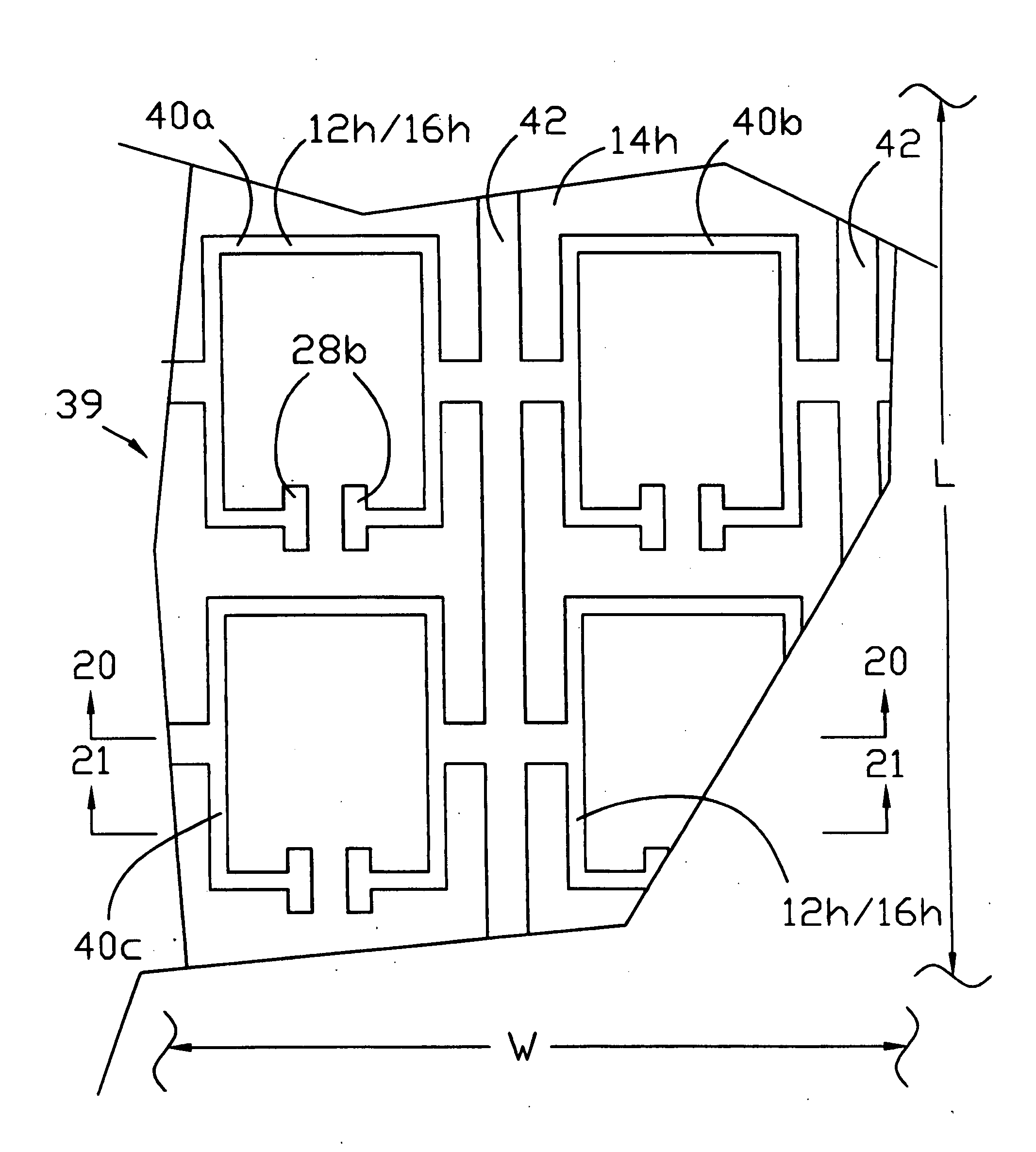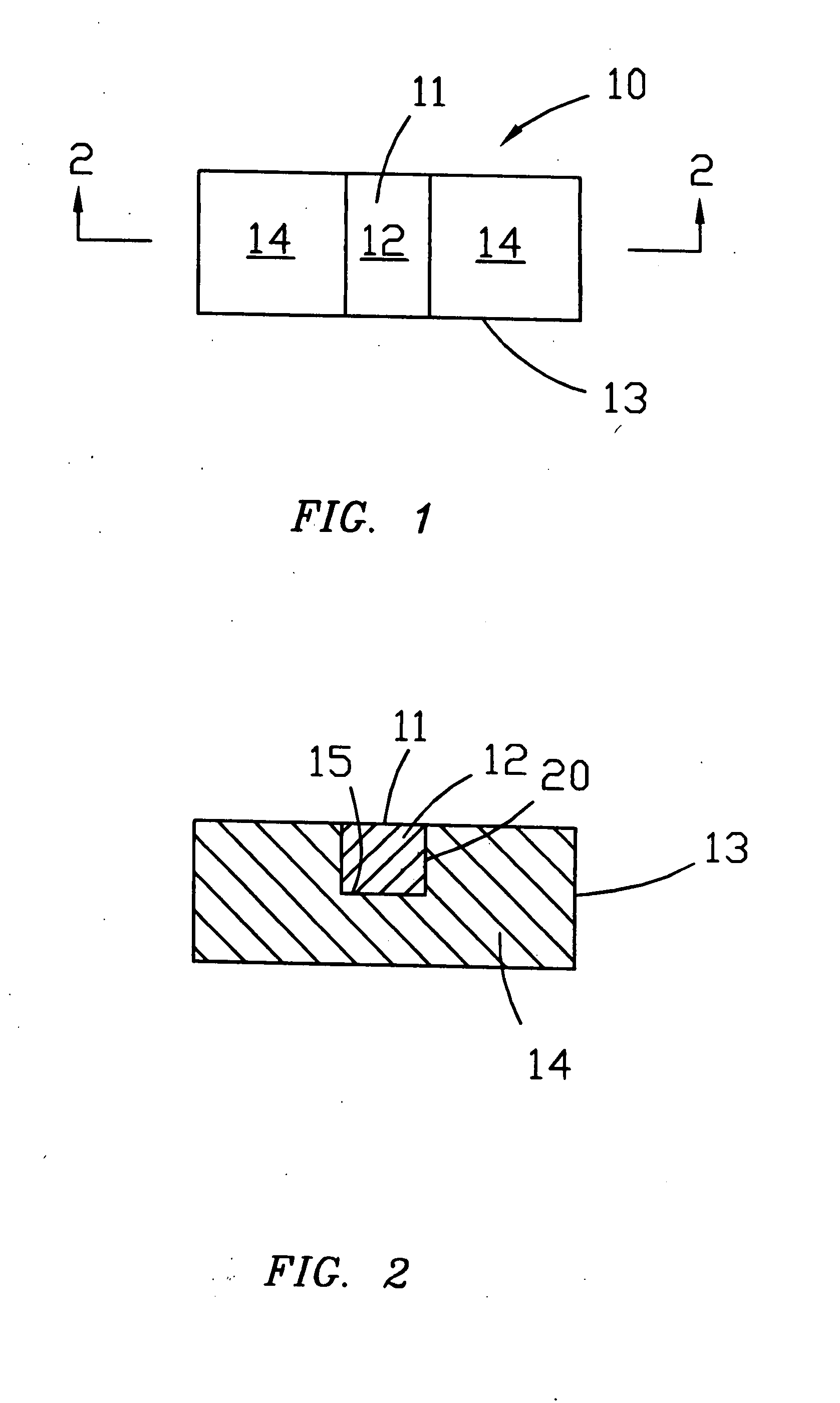The technique requires stripping of insulation and individually connecting the opposite ends of adjacent traces which is
time consuming and increases manufacturing costs.
However, the manufacture includes additional second surface metallization and possibly photo-
etching which increases complexity and cost.
However,
etching is wasteful and difficult from an environmental standpoint.
Thus it would appear that the unsupported wire bending taught in U.S. Pat. No. 5,809,633 could be difficult to achieve in volume manufacturing.
These techniques suffer from the relatively high costs of the conductive inks and a
high resistivity of these materials compared to substantially
pure metals.
Techniques for producing antennas by selective
etching suffer from excessive material waste,
pollution control difficulties and limited design flexibility.
The wire forming techniques proposed in these disclosures are, of course, limited in design flexibility.
However, the specialized tooling taught by Bumsted would appear to further reduce design flexibility and likely increase costs.
Other problems are associated with the “whip” antennas.
They are subject to damage, especially when extended, and can cause inadvertent personal injury.
The fact that they must be retractable increases
mechanical wear and limits possible size reductions for the device.
This design allows a longer antenna but increases complexity and cost and increases possibility of damage when extended.
This approach tends to increase the complexity of manufacture and precautions must be made to ensure and maintain proper spacing between radiator and
ground plane.
Cutting and forming of planar
metal sheets offers limited design options.
In addition, provision must be made to provide a
dielectric supporting structure between the two arms of the “U” since the sheet
metal would likely not maintain required planar spacing without such support.
These requirements tend to increase the size of the device.
The multiple pieces required for accurate positioning of the radiator plate relative to the earth plane increases the manufacturing cost of the Lehtola et al. structures.
Unfortunately, more complicated three dimensional
metal-based patterns often required for antenna manufacture can be difficult or impossible to produce using conventional mechanical wire winding, sheet forming or photoetching techniques.
Multiple operations, specialized masking and other complications are involved in production of the photoetched metallic patterns.
In addition, the metallic patterns produced were still restricted to a three dimensional structure made up of essentially flat
dielectric panels.
A
photomask cannot easily conform to the stem of the
mushroom while still permitting the
mask to be installed or removed over the cap of the
mushroom.
Thus, a significant limitation on design flexibility exists with Conventional photoetching techniques for production of three dimensional antenna structures.
The process taught by Crothall is clearly limited in its design flexibility by the
material removal requirement.
This technique avoids the complications of photoetching, but is still design limited by the requirement of applying the plating
resist.
Application of the plating
resist becomes increasingly difficult as the contours of the major surface become more complicated.
In addition, chemical
metal deposition is relatively slow in building thickness and the circuitry used is relatively expensive.
As
wireless communication devices continue to evolve, the demands on the design, size and manufacturability of the required antennas will become increasingly challenging.
Elliot taught non-circular or non-symmetrical
helical antennas, difficult to manufacture by conventional wire winding methods.
Nevertheless, the manufacturing methods proposed would be difficult and costly.
Unfortunately, the “plating on plastics” process comprises many steps involving expensive and harsh chemicals.
This increases costs dramatically and involves environmental difficulties.
The process is very sensitive to
processing variables used to fabricate the plastic substrate, limiting applications to carefully molded parts and designs.
It may be difficult to properly mold conventional plateable plastics using the rapid injection rates often required for the thin walls of electronic components.
The rapid injection rates can cause poor surface distribution of etchable species, resulting in poor
surface roughening and subsequent inferior bonding of the chemically deposited metal.
Finally, the rates at which metals can be chemically deposited are relatively slow, typically about one
micrometer per hour.
However, these techniques are very limited in design flexibility, as discussed previously.
This approach is design limited by the need for the stopoff
coating.
Selective
metallizing using either stopoff
lacquer of catalyzed resin approaches can be difficult, especially on complex parts, since the
electroless plating may tend to coat any exposed surface unless the overall process is carefully controlled.
Poor line definition, “skip plating” and complete part coverage due to bath instabilities often occurs.
Despite much effort to develop consistent and reliable performance through material and
process development, these problems still remain.
Multiple performance problems thwarted these attempts.
However, because of
fiber separation (holes) such a composite might not exhibit consistent “microscpic” resistivity.
Any attempt to make an acceptable directly electroplateable resin using the relatively small metal containing fillers alone encounters a number of barriers.
First, the fine metal containing fillers are relatively expensive.
The loadings required to achieve the particle-to particle proximity to achieve acceptable
conductivity increases the cost of the
polymer / filler blend dramatically.
The metal containing fillers are accompanied by further problems.
They tend to cause deterioration of the mechanical properties and
processing characteristics of many resins, limiting options in resin selection.
Finally, despite being
electrically conductive, a simple metal-filled
polymer still offers no mechanism to produce adhesion of an electrodeposit since the metal particles are generally encapsulated by the resin binder.
However, if
contact resistance is excessive or the workpiece is insufficiently conductive, the electrodeposition current favors the rack tip to the point where the electrodeposit will not bridge to the workpiece.
Moreover, a further problem is encountered even if specialized
racking successfully achieves electrodeposit bridging to the workpiece.
As with the bridging problem, the electrodeposition current favors the electrodeposited metal and the lateral growth can be extremely slow, restricting sizes for the workpiece.
Due to multiple performance problems associated with their intended end use, none of the attempts to simplify the process of plating on plastic substrates identified above has ever achieved any recognizable commercial success.
Conventional “electroless” plating technology does not permit this compositional flexibility.
Conventional “electroless” plating technology does not permit great flexibility to “custom formulate”.
 Login to View More
Login to View More  Login to View More
Login to View More 


